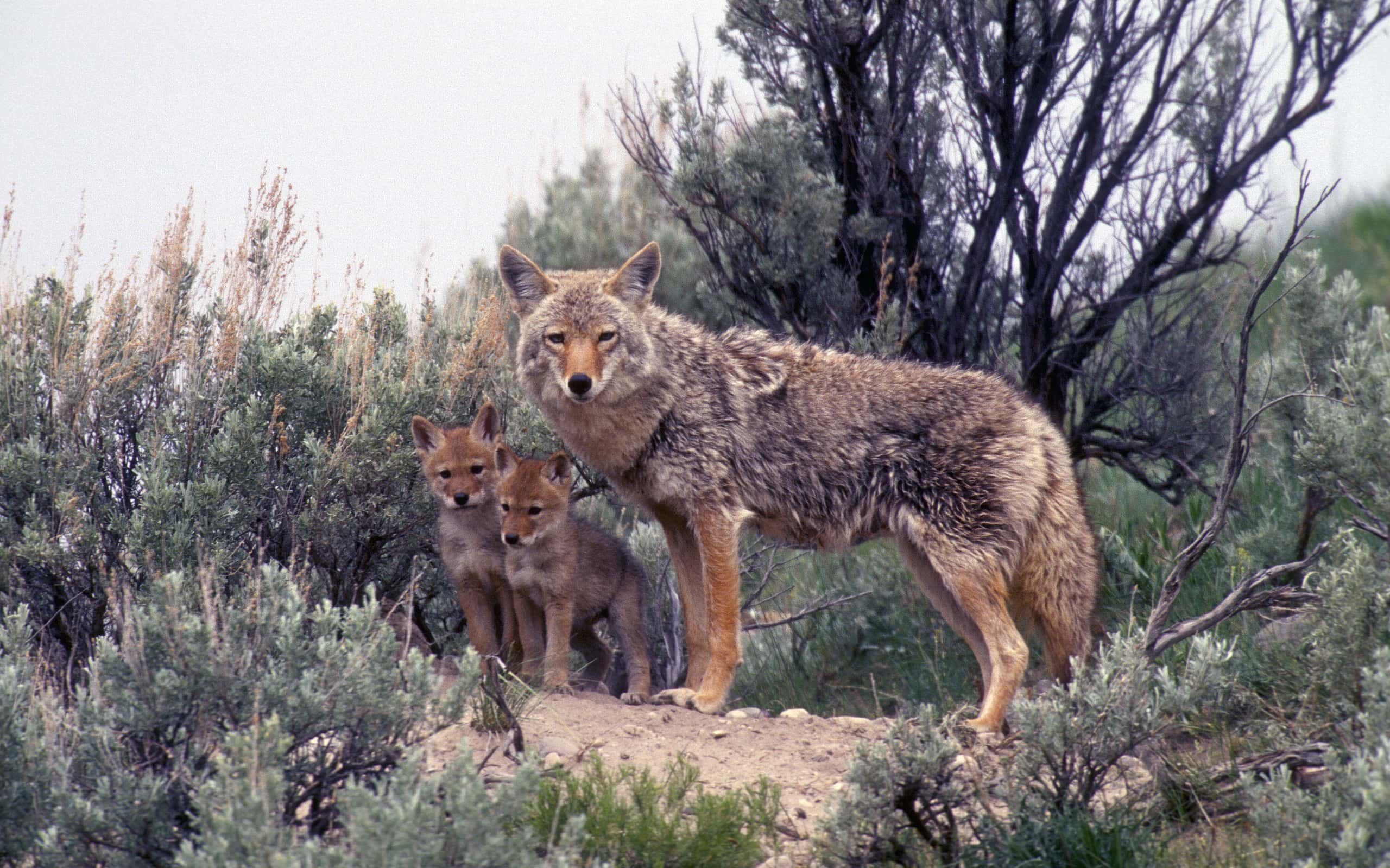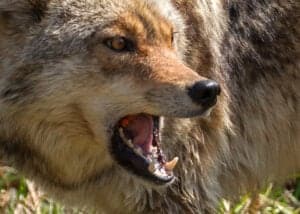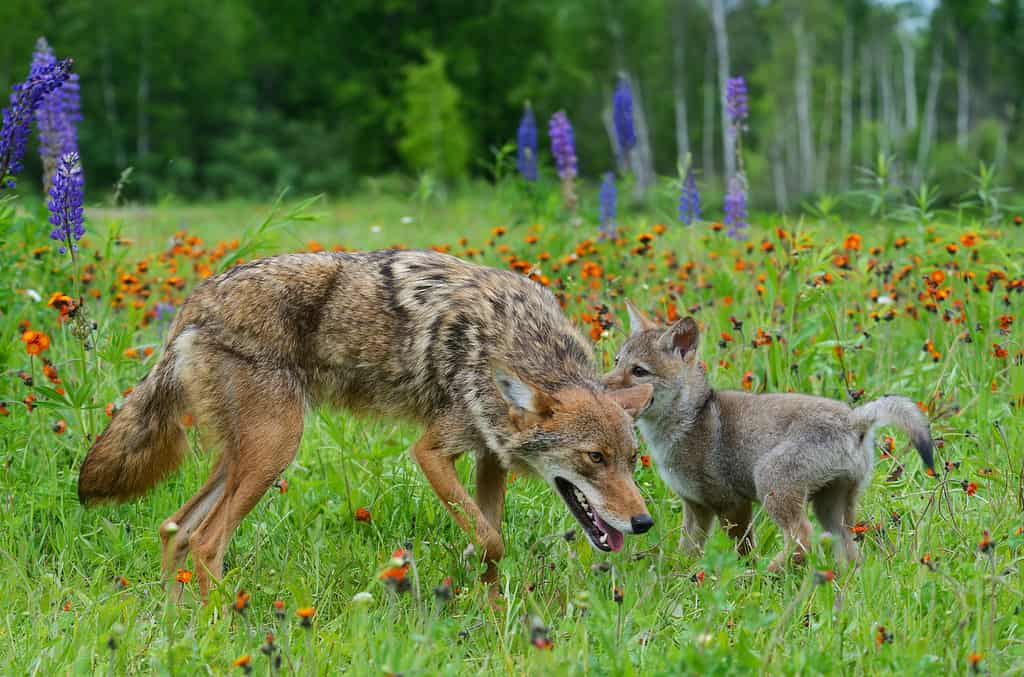
Coyotes can have four to seven pups in a single litter and will change based on population size.
©Betty4240/iStock via Getty Images
Connecticut is no stranger to wild animals lurking in suburban areas. Residents have to be wary of nuisance animals that creep out of the woods to forage for food in dumpsters and garbage cans overnight.
One of the most common animals in Connecticut are coyotes. Coyotes are not directly dangerous to humans, but they cause problems by invading backyards and preying on small pets.
How many coyotes are there in Connecticut? Are they dangerous to people? How big are coyotes? What should residents do if a coyote is in their backyard? We answer all these questions below.
What Coyotes Live in CT

Coyotes can live in dry, cold, warm, and wet climates, making them highly adaptable.
©Jillian Cooper/iStock via Getty Images
Canis lantrans, or the eastern coyote, is the only coyote species living along the U.S. Eastcoast. Coyotes living in other areas of the U.S. and Canada are classified as western variants.
An average coyote is 2 feet tall and weighs 22-33 pounds. They look like small wolves with pointed faces and bushier tails. Coyotes can live 10 to 14 years in the wild, and up to 20 years in captivity.
These canines are mainly carnivorous, requiring a diet of rodents, deer, or carrion (dead animal meat). Sometimes they will eat fruits to supplement their diet and provide extra hydration. Like bears, coyotes commonly enter neighborhoods to feed on discarded meat in trash cans.
Where Are Coyotes in CT?
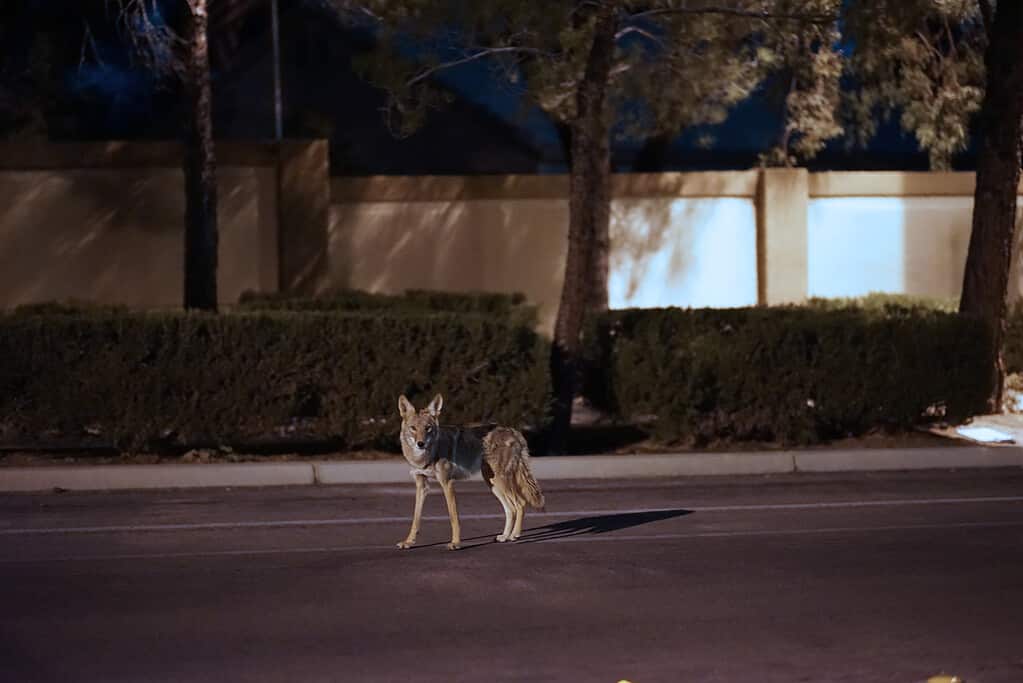
Residents can find these canines walking around the neighborhood on quiet streets.
©Zachary Byer/iStock via Getty Images
Wildlife biologist Jason Hawley of the Connecticut Department of Energy and Environmental Protection (DEEP) claims, “They are in every town in the state. There’s really no limitation to where they can be.”
Coyotes are adaptive predators and resourceful survivors. They can thrive in many environmental conditions so long as they have sufficient food, water, and shelter. Many coyotes will dig dens or claim a crawl space under a house to stay warm during inclement and wintry weather.
Coyotes can be active at all points of the day. Primarily, they hunt during the early morning and late evening, but sometimes they will hunt at night or during the day when there is little human activity.
How Many Live in CT
According to Connecticut local newspaper, The Day, approximately 3,000-5,000 eastern coyotes are living throughout the state. The species immersed themselves in the region during the 1950s and have been expanding ever since.
Why Are There in CT
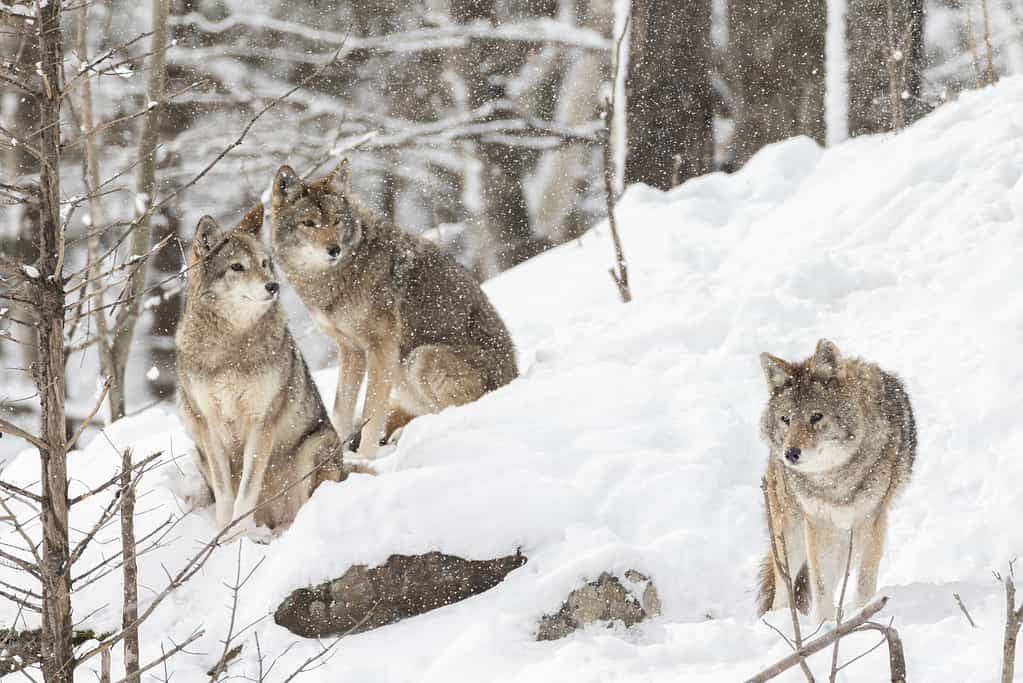
Like wolves, they live in packs consisting of three to seven members with a few pups.
©mirceax/iStock via Getty Images
Unlike bears and other predators living along the Eastcoast, coyotes are not native to CT.
Originally, the dominant predator in the region was wolves. The settlers and wolves clashed in the area for generations, eventually culminating in the eradication of the wolf population in the region.
During the 1930s, coyotes from the Midwest and Canada started expanding their territory. They found CT empty of larger predators and rich in food, so they moved in and reproduced. Coyotes filled an ecological niche left vacant by the wolf population.
Coyote Protection and Hunting Laws
According to the 2014 CT General Assembly report, there is no closed coyote hunting season, except during seasons when other hunter game is open. This means that people with government-approved hunting licenses may hunt coyotes throughout the year with no limit.
Hunters may only hunt coyotes during these specific times:
- 30 minutes before sunrise
- 30 minutes after sunset
- Daytime
- Sunday (only within shooting preserves and with permission from the town)
- While other hunting seasons are closed
Any hunter violating these rules will be charged with a misdemeanor and punished with a $250 fine, imprisonment of up to 30 days, or both.
Currently, there are no laws protecting coyotes outside of laws stating they cannot be taken in as pets. All killed coyotes must be reported to the DEEP.
How To Deal with a Nuisance Coyote

Coyotes with mange look very sickly and unrecognizable to anyone not familiar with mange.
©Wirestock/iStock via Getty Images
A nuisance coyote is any coyote that is causing property damage or presents a threat to human health. Nuisance animals are common in all states, and each state has specific rules on dealing with them.
Connecticut’s DEEP does not handle nuisance coyotes. The canines are so prominent throughout the state, that they transfer out the duties of nuisance coyote removal to registered hunters and trappers. Residents can become certified in hunting and trapping for extra income or to support the community.
Alternatively, residents may shoot coyotes if they are actively causing property damage or presenting a danger to human health.
Residents should call the DEEP Wildlife Division at 860-424-3011 to request a hunter or trapper to remove a nuisance coyote.
Are Coyote Attacks Common
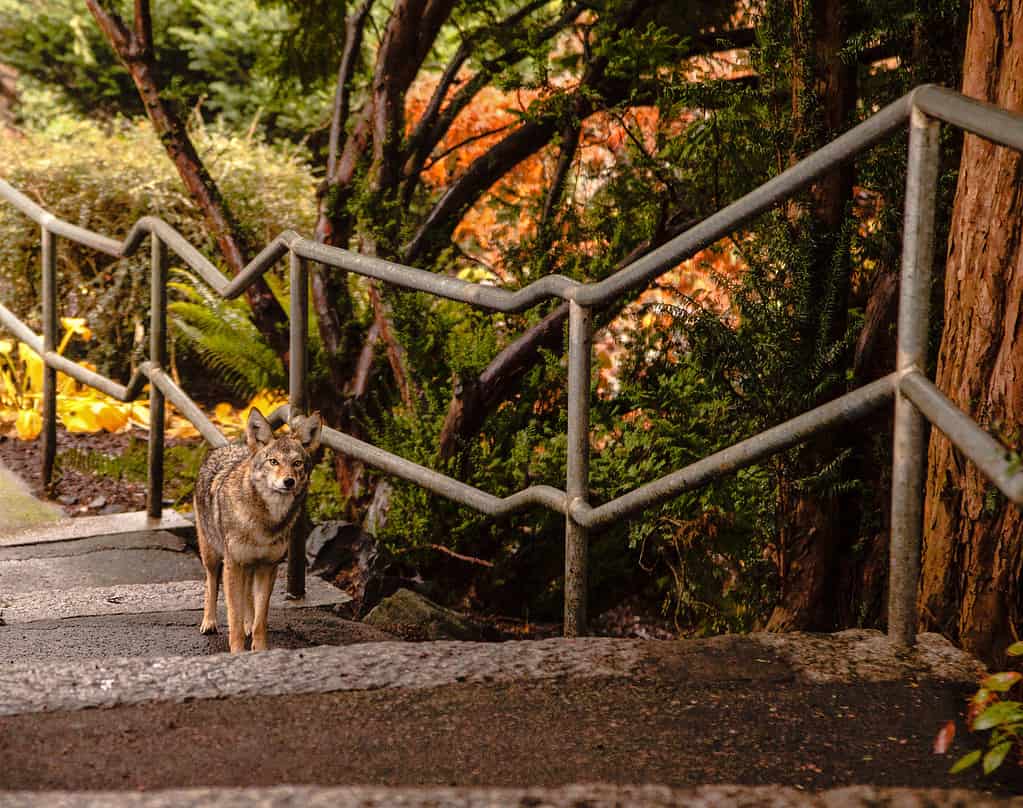
Coyotes will commonly hunt for rodents and birds in parks, lurking in bushes for a surprise pounce.
©northohana/iStock via Getty Images
Surprisingly, there are very few reported cases of coyote attacks on humans. Coyotes have no interest in attacking people because humans are large predators. Animals will opt to flee rather than combat a larger predator, knowing they are at a disadvantage.
However, coyotes are susceptible to rabies, which increases their aggression levels. Rabid coyotes are extremely dangerous because rabies is a lethal virus that spreads to other animals and humans. Thankfully, rabies cases are uncommon thanks to vaccinations.
There are dozens of coyote sightings across the state because of the dense population in CT. Additionally, people see more coyotes during the spring and summer, when people are outside more often.
Coyotes are likelier to attack pets like indoor/outdoor cats or small dogs left unattended in the yard. Small dogs are easy prey for coyotes.
People who go camping or go to parks in the early morning or late evening have the highest chance of encountering a coyote.
What to Do When Encountering a Coyote
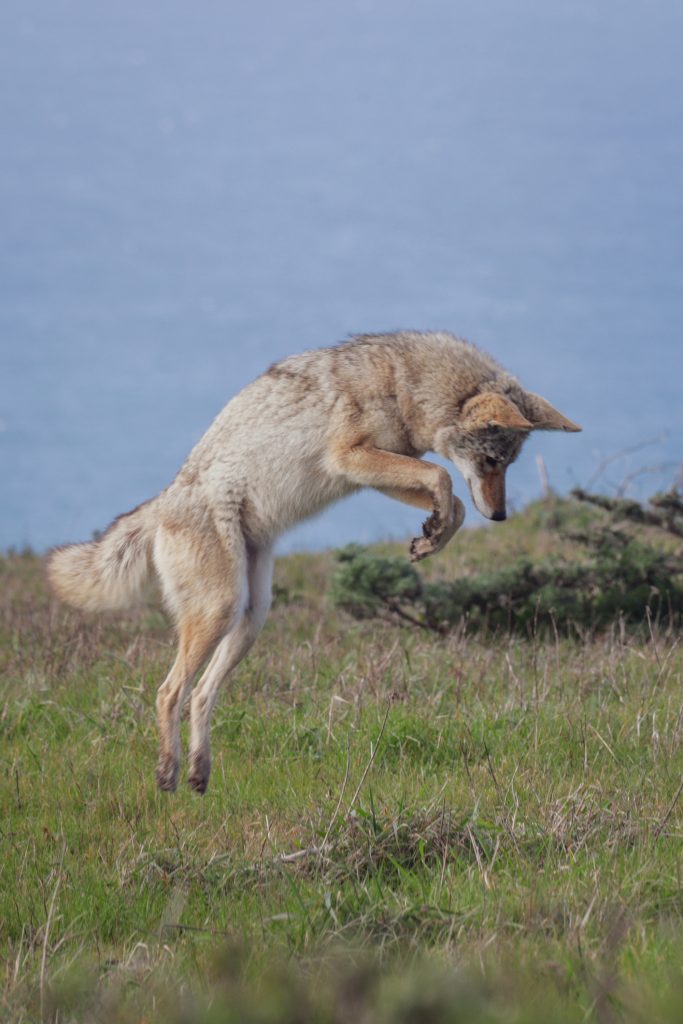
Some coyotes will work with badgers to chase prey burrowing underground.
©Doug Michaels/iStock via Getty Images
Even though coyote attacks are uncommon, the CT DEEP provides clear instructions on how to prevent a coyote attack and offer contact information for the proper authorities to report an encounter.
Follow these tips to prevent coyote encounters:
- Do not feed: Residents should never feed wild animals. If wild animals associate humans with food, they will lose their fear of humans, increasing the chances of an attack.
- Watch over pets: Always monitor pets while on a walk or in the yard, especially in the morning and evenings. Small-breed dogs are vulnerable prey to coyotes, and they will try to get them for an easy meal.
- Leash walks: Even if pets are “off-lead” trained, use a leash at all times while walking a dog. Coyotes are fast, and agile, and will catch unsuspecting prey off guard. A leash allows owners to have a secure way of controlling their pets to avoid them running or being carried away.
- Microchip pets: Microchips are a painless and inexpensive method of tracking pets. In the event of a dog getting lost or attacked, the microchip can help owners recover their pets quickly.
- Make sound and look big: People should make themselves look as big as possible while making loud sounds to deter coyotes. This tricks coyotes into believing the individual is much larger and scarier than they appear.
- Report abnormal behavior: Normally, coyotes do not go near humans. But if a coyote is stalking a child, looks sickly, or is chasing people, then it should be reported immediately to the DEEP. Residents should provide a precise location of the encounter, time of encounter, and photo evidence if possible.
- Lock-up crawl spaces: Residents should securely lock or block crawl spaces to prevent coyotes from accessing them.
- Communicate and educate: Speak with neighbors about coyote encounters to identify unusual behavior or increased sightings. Also, teach children the differences between coyotes and other big dogs, as well as safety protocols.
Coyotes may not be native to Connecticut, but they are here to stay, and it is up to residents to learn to coexist with these animals for the safety of both species.
Thank you for reading! Have some feedback for us? Contact the AZ Animals editorial team.

